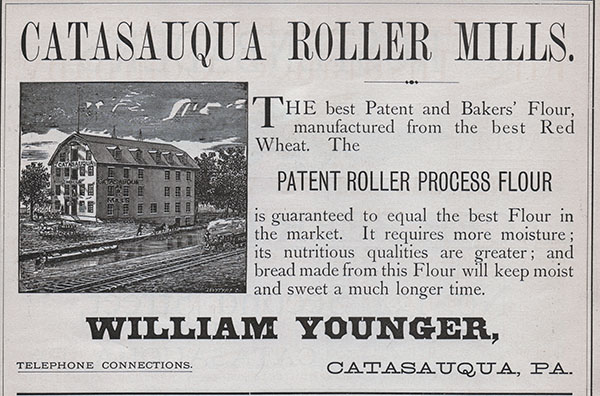A mill in Catasauqua dates back to the mid-eighteenth century, by tradition 1752. Located at what is now the southwest corner of Lehigh and Race streets, the mill originally operated with water from the Catasauqua Creek.
*
Technically, it was not ever part of the Mauser Mill Company.
Timeline
The initial mill was built of stone, approximately 30 x 40 feet. By 1792, an old map indicates that the mill was owned and operated by a Colonel Deshler as Deshler’s Mill. Frederick and Henry Biery purchased the grist mill as part of the area that became known as Biery’s Port.
In 1856 Mr. Milton Berger and William Younger, operating as Berger & Younger, took over the mill. After Berger died in 1871, four years later Younger purchases share from Berger estate to become sole owner of the Catasauqua Roller Flour Mills. By that time, the mill was a wood-frame structure, approximately 40'x100', five stories high, built on the old stone foundation of the original mill.
In March 1895, George S. Mauser purchased the grist-mill and adjoining property ($20,000) from the bank for his son, Franklin Mauser, and son-in-law, Allen Cressman. They proceeded to carry on the milling business as Mauser & Cressman. The mill was expanded and re-oriented to rely on water from the Lehigh canal instead of the creek.
On 29 April 1898, the mill burned to the ground. The fire was discovered by a crew on the adjacent Central of New Jersey railroad, but fire companies were unable to save the structure. After about a month or so of indecision, it was decided to rebuild, modernize and expand the mill (using brick).
In December 1898, George Mauser sold Catasauqua mill to his son, Frank Mauser, and his son-in-law, Allan Cressman. (The Allentown Leader, 6 December 1898)
By January 1899, the mill was back in full operation. It was a brick building, three stories high with a mansard roof with two cupolas. Erected by Loughridge & Mullen, it had steam heat and was equipped with Case manufacturing equipment capable of processing 150 barrels of wheat per day. The water wheel was rated at 300 HP. (The Allentown Democrat, 5 April 1899)
In 1901, the mill added an addition, 85' in length, to store, four, hay, straw, etc., and a cooper shop was erected to build barrels for flour storage.
The first of several floods that would affect the mill's operation occurred in December 1901 when flooding washed away part of the canal, and that affected the mill's source of water for operations. A temporary dam had to be built to bring the canal water level up to a level to be able to supply water to the mill, the neighboring silk mill and the electric light house. In February 1908, it was the Catasauqua Creek that flooded and washed away part of the canal tow path.
In 1911, another expansion of the mill was carried out by the Wolf Company of Chambersburg. This was to upgrade capacity to 400 barrels of flour a day, thus making it largest mill in the Lehigh Valley. (The Morning Call, 11 February 1911)
By November 1918, the mill could produce more than 1,400 barrels of flour per week. The mill had an elevator of 35,00 bushels.
In September 1942, there was some flooding in the basement of the Mauser mill. Then in 1945 the mill was put out of commission by flood waters which completely changed the course of the canal. (The Morning Call, 11 July 1945)
By 1962, the Mauser mill in Catasauqua was vacant. I am not exactly sure when it ceased production.
In January 1964, there was a notice of the former Mauser Mill property at Race & Lehigh Streets for sale, 20,000 sq. ft. with further open parking space.
In November 1978 fire gutted the brick building, the former Mauser Mill, which was about to be sold again for storage. (The Morning Call, 8 November 1978)
